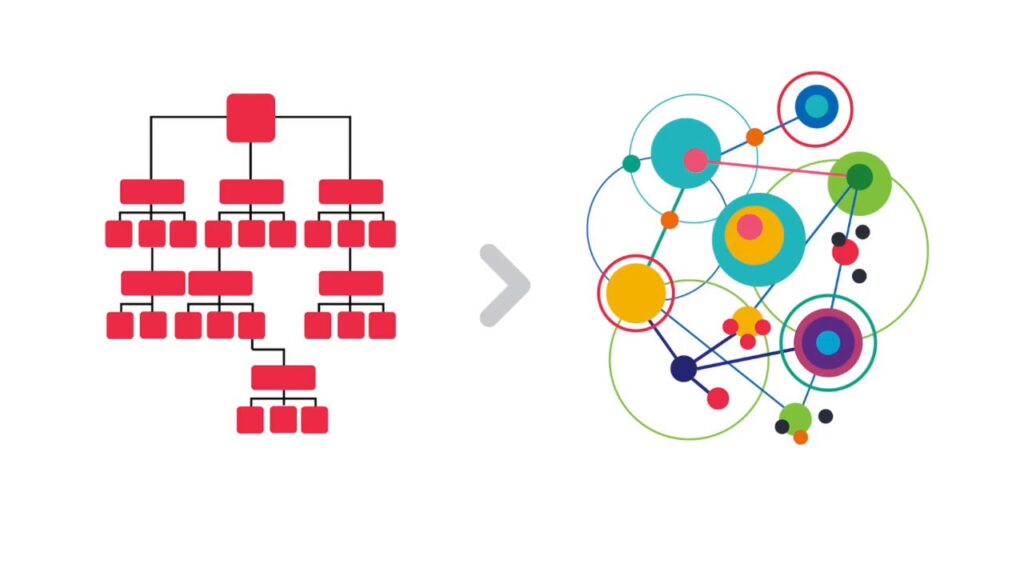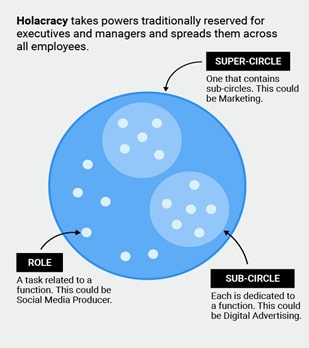
Hola-what? Holacracy! A relatively new and innovative approach to organizational structure, holacracy is defined as:
- “A method of decentralized management and organizational governance, which claims to distribute authority and decision-making through a holarchy of self-organizing teams rather than being vested in a management hierarchy. Individual employees can take on a role or multiple roles and shed those roles if/when they are no longer necessary.”
Essentially, holacracy does away with the more traditional, multi-tiered hierarchal organizational structure and instead allows for individual teams (and the individuals within those teams) to act autonomously, yet cohesively with others in the organization.
An example of what holacracy looks like:

To be clear, holacracy is not the total elimination of hierarchy. Instead, a holacracy is a hierarchy of “circles” (or “groups”, or “teams”, or “squads” – whatever you collectively decide to call them) as opposed to a hierarchy of positions or individuals. These circles are made up of individuals who assume specific roles, and those individuals can assume multiple roles across different circles as needed. Holacracy uses a collective process called “governance meetings” to define roles, and once defined, each person filling a role (or roles) has full autonomy and authority to execute operationally. While each circle is accountable to the circle that succeeds it, the concept of individual managers is eliminated, and individual contributors instead have full accountability for their work.
To many people, the idea of removing managers makes holacracy sound hola-crazy. With distributed authority and employees having full autonomy over their work, it is easy to envision organizations spiraling into complete and utter chaos; and for business leaders who take lightly the decision to implement a holacracy and venture forth unprepared, that is precisely what will happen: chaos, confusion, and a revolving door of employee turnover. That is why, to have any hope of running a holacracy successfully, organizations must develop and strictly follow a holacratic constitution that clearly outlines the roles, decision-making processes, and procedures to ensure that each individual and team within the organization understands and operates within the boundaries in which they have the freedom to act.
If it sounds complex, that is because it is. So, the question is, why would any business want to operate as a holacracy? Theoretically, there are a few key benefits that a holacracy more readily provides than a traditional hierarchal structure:
- Because individuals can assume multiple roles within different circles, holacracy can prevent the formation of silos and provide teams and individuals with greater transparency and insight into what the organization is doing as a whole.
- Holacracy can give employees greater autonomy and a sense of ownership over their work, potentially leading to increased personal accountability, greater employee engagement, a heightened sense of purpose and fulfillment, and greater opportunities for innovation.
- Holacracy can allow individuals within the organization to take on and offload various roles and accountabilities as required, potentially increasing organizational agility and responsiveness to changing internal and external factors.
However, these potential benefits cannot be realized without the growing pains that come along with going against the tried-and-true traditional hierarchy. Because holacracy is not yet common practice and goes against what most employees are naturally accustomed to, organizations operating as a holacracy must, in general, provide a lengthy onboarding and training program that focuses on teaching employees the processes, procedures, and expectations unique to the holacracy. Despite these training efforts, many holacratic organizations still experience higher rates of employee turnover due to the organizational structure being perceived as confusing, overwhelming, and unappealing, particularly to those who are looking for a more traditional structure with clearer lines of authority and career progression. Indeed, the fluid nature of roles within a holacracy requires not only business leaders and HR professionals to take a creative approach to employee development and compensation planning; but also, employees to remain open-minded and flexible in their definition of success and their path towards it.

Another point business leaders should consider before delving into holacracy is that because organizational and team decisions rely on governance meetings, the decision-making process can be tedious and much more time-consuming when compared to traditional hierarchal structures. While governance meetings more readily allow for employee voices to be heard and various perspectives to be considered, employees not keen on holacracy may “check out” and refuse or fail to make meaningful contributions, making these foundationally important meetings wildly unproductive.
For holacracy to work as intended, every member of the organization must be actively engaged and committed to observing the principles and practices of the holacracy. With that said, perhaps the biggest weakness of holacracy is its relative lack of resilience when faced with gaps between an organizations “espoused theory” (i.e., what leaders say about the culture, values, and management principles) and “theory in use” (i.e., what is happening in reality). Because the union (or disunion) between espoused theory and theory in use is largely driven by employee behavior, the more employees there are acting autonomously within an organization, the more difficult it becomes to manage the organizational structure and ensure internal cultural alignment.
While holacracy is an undoubtedly creative approach to organizational structure that could have some practical advantages, it certainly is not without its inherent challenges. It is worth noting that many of the potential benefits of a holacracy can also be achieved in a traditional hierarchy by simply implementing organizational practices that promote greater transparency, employee engagement, and improve performance management.
With that said, some business leaders are eager to take a stand against the hierarchal structures of old and do something innovative that has the potential to be greatly rewarding to the business and its people; and TSERGAS Human Capital is here to support those leaders in making the right organizational design decisions for their business.

Cierra James-Hahn
Senior HR Management Consultant
Cierra is an experienced human resources professional with a comprehensive background in recruitment and onboarding, contract writing, compensation and benefits, health and safety, and policy development.